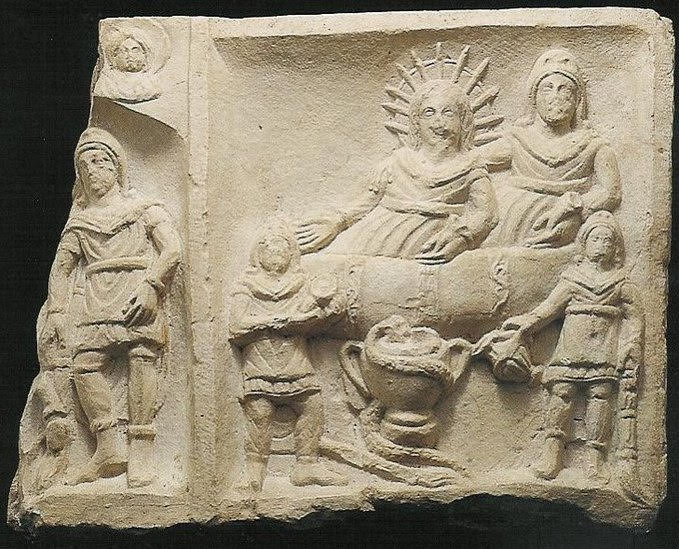
CIMRM 798 - Tauroctony and banquet relief, Lisbon, Portugal.

The New Mithraeum (@TheNewMithraeum) Tweeted: Another example from Tróia is now exposed at the @MNArqueologia of Lisbon. During the earthly feasts, the father of the community took the role of Mithras, Heliodromus that of the Sun, and the rest of the initiates dressed according to their degrees.
CIMRM entry
CAETOBRIGA
798.
Relief, broken in four pieces, found at Troja near Setubal. Museo Etnologico in Lisbon.
Mendes da Costa in Arch. Port., XXIX, 1930--1931, 5ff and fig. 26; Pidal, Hist. Esp. II, 441 and fig. 250; Cumont in CRAI 1934,262; RA 1946, 191 and fig. 4; Jalbay in Broteria, XLVI, 1948, 529ff and figs. 3-4. See fig. 217, which we received from Franz Cumont.
A scene of Mithras tauroctone, of which only the foreleg of the bull and a torchbearer in Eastern attire before if are preserved. The torch is pointed downwards; not cross-legged (Cautopates). In the r. upper corner, above a vaulting, the dressed. bust of Luna with crescent behind her shoulders.
Beside it, separated from it by a vertical rim a representation of Mithras and Sol reclining at table. Mithras in Eastern attire holds a rhyton in his right, just as his fellow-guest, but he holds his r.h. behind Sol's shoulders, who is recognizable by his aureole and crown with seven rays. The latter extends his r.h. to a servant, Who offers a plate with two loaves(?). The burning torch of the servant lies on the ground beside a krater with two ears, against which a serpent is winding its way up in order. to drink out of it. A second servant, dressed in Eastern attire as his companion, points his torch downwards with his l.h. and with the other ne is about to empty the contents of a vase into the krater.
| Tweet |